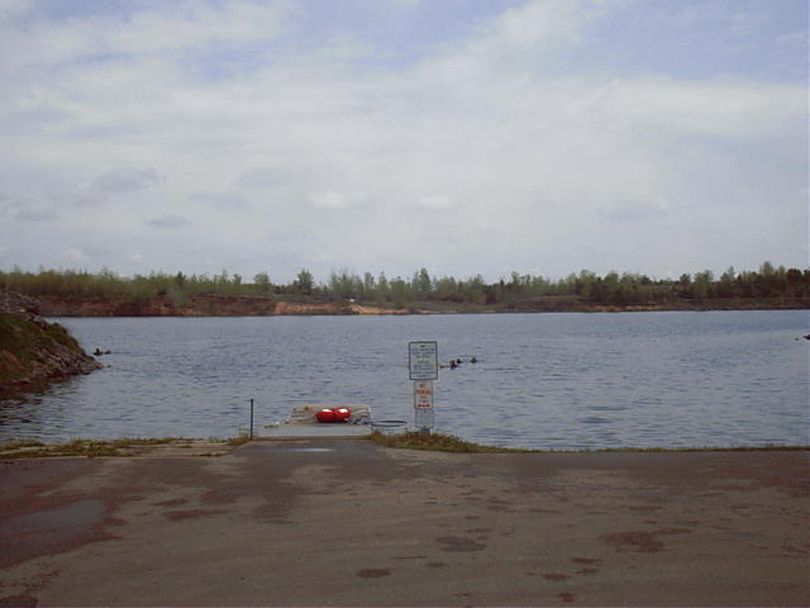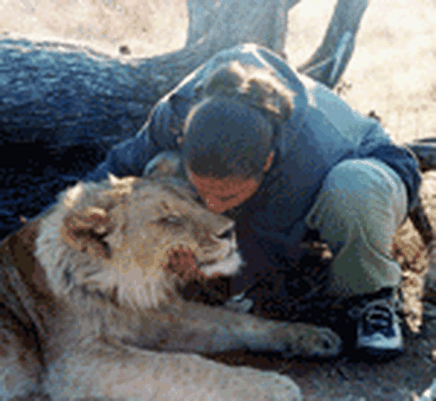Diving in Wisconsin?

I'm a warm water diver, no doubts about it. As my dad (the hard-core, dive-in-any-temperature instructor) puts it, I'm a 'fair weather diver'. Or, as he prefers, 'pansy'. Fair enough. Cold water diving has never appealed to me, dry suits are the invention of insanity, and ice divers... well, I've got several descriptors for those people but none can be put in print.
But when the opportunity to lake dive in Wisconsin came my way, I couldn't say no. I thought it would at least put my father's loving commentary on hold, and it would always give me a card to play in later conversations regarding my dedication to diving. And besides, it sounded kind of cool.
Back in the 1960's, Jackson County Iron mined an area just outside of Black River Falls, Wisconsin. Once breaking through to the water table, high pressure pumps were installed to keep the mine shafts clear of water while they continued mining. When active mining ceased in 1983, the water pumps were removed. With the water no longer being diverted, the quarry was eventually submerged and now forms Wazee Lake.
Under the surface of this 355-foot deep lake one can find the remnants of a mining netherworld. Roads used for trucking out the ore, leftover artifacts such as pipes, chains and old ore pellets, and even mini forests litter the lake floor. Additionally, various species of fish have been introduced to the lake and fish cribs have been installed to offer a sort of artificial reef for those fish. Considering that this is an inland, man-made lake, there's quite a lot to see, which explains the draw for SCUBA divers and justifies the $10 per day dive fee.
The steep cliffs of the original quarry rise above the surface of the water, allowing access to the lake at only three designated dive sites and one sandy beach. Diving and fishing are the lake's big draws as motorized craft of all sorts are banned. The lack of oil slicks and motors buzzing overhead increases diver visibility, safety, and I must add, overall enjoyment of the quiet underworld.
Though the lake area includes a campground, prior to making the drive to Wisconsin I was unable to get my hands on a tent or other camping gear, so I resigned myself to pitching up in a hotel for the weekend. Throwing my dive gear in the car, I headed out for what I assumed would be a freezing cold dive trip with people I didn't know. But I wasn't too worried. After all, I would be diving with Minnesotans (that's like getting a guarantee on niceness) and I had packed my new 7mm wetsuit, complete with hoodie, so was as prepared as possible for the cold.
Rucking up at the campsite to check in, I was immediately welcomed by and invited to stay with a family that happened to have a spare bed in their camper ('Minnesota nice' doesn't begin to describe this family's hospitality). We sat around the campfire, traded stories of youthful indiscretions and stared at the stars. Waking in the morning, I rolled out of bed to the smell of sizzling bacon. Ahh. Belly full, the man of the camper and I headed over to the dive site, me nervously asking how cold the water temperature tended to be this time of year. "Oh, the water temperature will be fine. It's getting out that'll be cold."
How reassuring.
At 9am, the sun was out and the clouds were fluffy. An excellent sign. The more light we had on the dive, the better our visibility. And more importantly, the warmer I would be after the dive when I would have to strip off my soaking wetsuit. By ten, as we were still waiting for everyone to show up and get their gear sorted, dark clouds had rolled in and the wind had whipped up. I started seriously rethinking the dive. Yeah, I was already there, but couldn't I just enjoy a weekend camping? Was it really necessary to dive? When the cloud cover broke at ten thirty, I crawled into my wetsuit before my mind changed itself again, and by eleven we were hitting the water.
The first few moments were telling. As dribbles of water found weak points in my armor, I could feel rivulets of ice creeping their way down my back and into my boots. Gritting my teeth like a proper imbecile, I plunged in, dunking myself before I could make a run for shore. And I was pleasantly surprised by my 7mm of protective coating. Aside from feeling like my hood was strangling me, I was quite comfortable. In a few minutes, the constricting, choking sensation passed and I was free to enjoy the muck and mud stirred up by the divers before us.
Heading away from the trainees, we found the drop off and stayed just above it. At about 10 meters (30 feet), the water was pleasant. Not warm per se, but more than bearable. I wasn't shivering or counting the time until I could surface and start pouring hot chocolate down my throat in an effort to regain sensation in my toes (I was playing scenario in my head before the dive- does it show?).
Instead, I was actually able to enjoy the dive. We found the divers' toilet at 7 meters, to be used in the event of an emergency, I suppose. We saw fish I couldn't begin to identify, and we found a tie-line that led into the depths, which we followed. In retrospect, not a good idea as the visibility wasn't the greatest. Hoping for some sort of payoff, we let it lead us down and away from shore. Hitting the upper thermocline (there's another one deeper down... brrr!), the temperature adjusted itself to fit my fears. Two minutes later, I knew exactly what an Otter Pop felt like. Ten seconds after that, we were heading upwards for the (comparatively) balmy water above. Once breaking back through the thermocline and getting feeling back in our cheeks and hands, we realized we couldn't see the walls of the lake. And none of us had been savvy enough to take a compass bearing before heading off on our grand adventure of the tie-line.
In that moment, I learned the best aspect of diving in a lake: No current, no fear. Ascending to the surface, we got our bearings and headed back to shore. And the sun even made a little appearance while I dried off.
Later that afternoon we headed in for our second dive of the day. I debated getting wet again. After all, I had done what I came to do, accomplished my goal, and could proudly wear the inland lake diving badge of honor. But what the hell, my gear was already wet and if we stayed above the thermocline (the point where the shallower warmer water meets the deeper colder water- the colder water actually creates a visible haze) I couldn't get too cold for comfort.
The second dive was even better than the first. To start, the trainees from the morning were gone, increasing visibility significantly, and the sun graced us with its presence for nearly the entire dive. At one point a cloud blocked the rays and all I could think was, "Who switched off the light?" It was flipped back on a moment later, and we were given the rare treat of sunlight filtering through the shallows to create an idyllic silent paradise. Also, we went to the left this time and at five meters found a gnome garden. Some impish divers, wanting to give the lake some additional landscaping, had filled lawn gnomes with concrete and sank them into the dive site. It was like an entertainingly eerie version of Disneyland.
After surfacing, all we had left for the day was dekitting, packing our gear, and drinking around the campfire. And while the rain did finally make a nasty appearance, I thoroughly enjoyed my cold water diving experience. I wonder when the next ice diving trip is?
